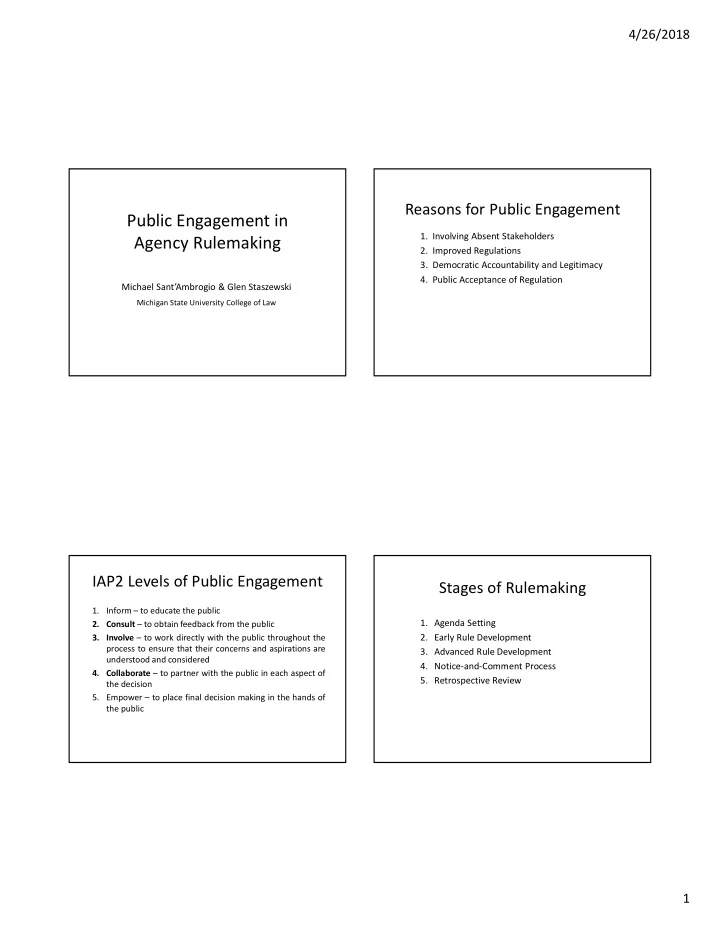

4/26/2018 Reasons for Public Engagement Public Engagement in 1. Involving Absent Stakeholders Agency Rulemaking 2. Improved Regulations 3. Democratic Accountability and Legitimacy 4. Public Acceptance of Regulation Michael Sant’Ambrogio & Glen Staszewski Michigan State University College of Law IAP2 Levels of Public Engagement Stages of Rulemaking 1. Inform – to educate the public 1. Agenda Setting 2. Consult – to obtain feedback from the public 2. Early Rule Development 3. Involve – to work directly with the public throughout the process to ensure that their concerns and aspirations are 3. Advanced Rule Development understood and considered 4. Notice-and-Comment Process 4. Collaborate – to partner with the public in each aspect of 5. Retrospective Review the decision 5. Empower – to place final decision making in the hands of the public 1
4/26/2018 Agenda Setting Levels of engagement + Stages of RM = Modes of Public Engagement 1. Rulemaking Petitions (1) Why does agency want to engage with the public? 2. Advisory Committees (2) Who is the agency trying to reach? 3. Focus Groups (3) What type of information is the agency seeking? 4. Requests for Information (4) How is this information most likely to be 5. Public Hearings/Listening Sessions obtained? 6. Hotlines or Suggestion Boxes (5) When should these efforts occur? 7. Public Complaints (6) What will the agency do with this information? 8. Notice & Comment Related to Agenda 9. Enhanced Deliberative Exercises Agenda Setting Rule Development Modes of Public Engagement • Under what circumstances is public engagement 1. Advisory Committees with agenda setting most/least useful? 2. Focus Groups 3. Requests for Information (early) • What are the most/least effective means of 4. Public Hearings/Listening Sessions engaging the public in agenda setting? 5. Internet and Web-Based Outreach 6. Status updates & Impact Reports 7. Advance NPRMs (advanced) • What are the limitations or challenges of public 8. Negotiated Rulemaking (advanced) engagement in agenda setting? 9. Development of Plain Language NPRMs (advanced) 10. Enhanced deliberative exercises 2
4/26/2018 Notice & Comment Rulemaking Rule Development Current Status and Challenges • When is public engagement with rule development most/least useful? • Formally most open part of rulemaking to the public – Anyone may comment • What are the most/least effective means of – Agency must respond to salient comments engaging the public in rule development? • Frequently dominated by sophisticated stakeholders • Difficult for unsophisticated stakeholders to effectively • What are the limitations or challenges of public comment on long, complex, and detailed proposals engagement in rule development? • Perception that agency has already made up its mind • Legal constraints on dialogic communications Notice & Comment Rulemaking Notice & Comment Rulemaking Enhancing Public Engagement • When are supplemental efforts to engage the public in notice & comment rulemaking most/least useful? 1. Plain-language NPRMs 2. Effective Commenting Tutorials • What are the most effective strategies for facilitating 3. User-friendly, dynamic e-rulemaking dockets engagement with rulemaking by absent or 4. Status Reports and Notifications unsophisticated stakeholders? 5. Reply Comment Periods 6. Public Hearings • What are the limitations or challenges of 7. Supplemental Deliberative Exercises supplemental efforts to engage the public with notice & comment rulemaking? 3
4/26/2018 Retrospective Review Retrospective Review Modes of Public Engagement • When is public engagement with retrospective 1. Rulemaking Petitions review most/least useful? 2. Advisory Committees 3. Focus Groups • What are the most/least effective means of 4. Requests for Information engaging the public in retrospective review? 5. Public Hearings/Listening Sessions 6. Hotlines or Suggestion Boxes • What are the limitations or challenges of public 7. “Living” Rulemaking Dockets engagement in retrospective review? 8. Public Notice and Comment Incentives and Regulatory Culture The Importance of Planning There are many, many examples of agencies engaging in • How should agencies plan for public engagement? meaningful public engagement in rulemaking – • Should agencies develop specific plans for each • How do we establish incentives to improve on existing rulemaking initiative that an agency undertakes or practices and institutionalize best practices in this seriously considers? What should they include? area, particularly when flexibility is needed and uniform legal requirements may be undesirable? • What are the challenges to planning for public engagement in rulemaking? • What are the challenges or obstacles to enhancing public engagement? 4
4/26/2018 Toward Deliberative Democracy Outreach and Communication • How can agencies reach targeted stakeholders, Enhanced Public Deliberation in Rulemaking persuade them to participate, and provide them with 1. Regulation Room tools to do so effectively? 2. Citizen Juries 3. Citizen Advisory Committees • What are the challenges or obstacles to reaching and 4. Citizen Assemblies incentivizing participation by the public in agency 5. Deliberative Polls rulemaking? 6. 21 st Century Town Meetings 7. Participatory Budgeting Public Deliberation in Rulemaking • When would deliberative exercises like Regulation Room be most useful and worth the effort? • What are the limitations or challenges of undertaking highly deliberative exercises? 5
Recommend
More recommend